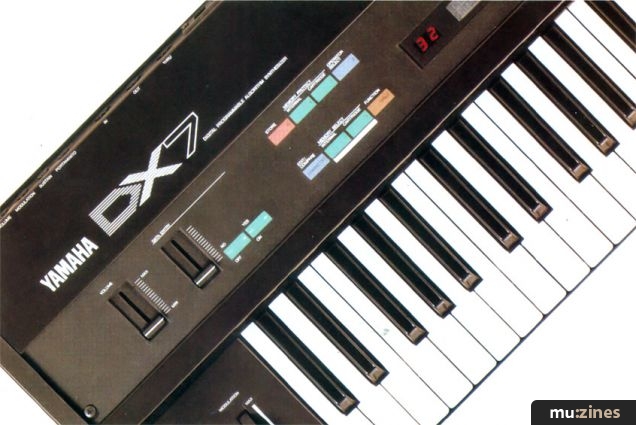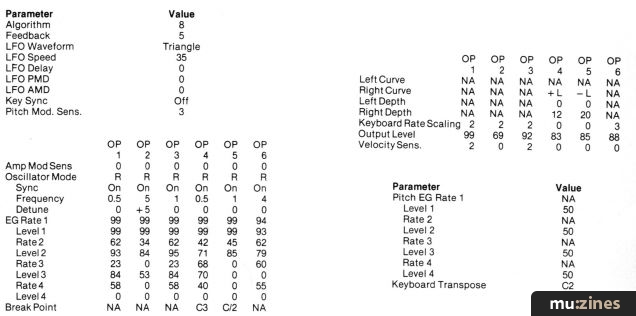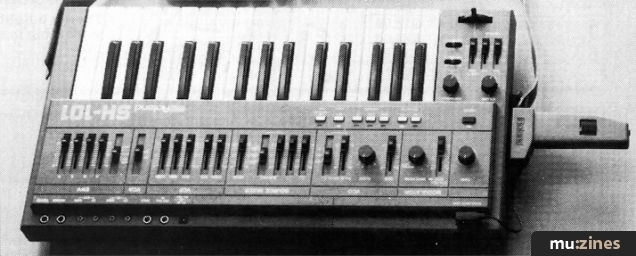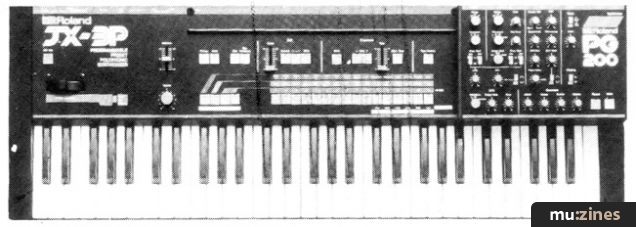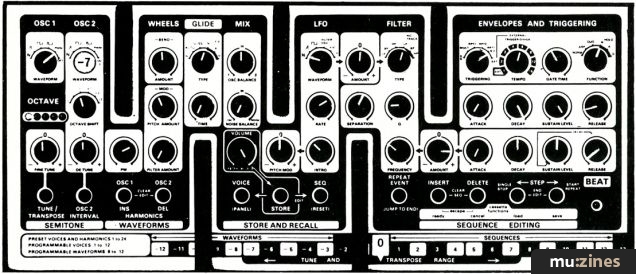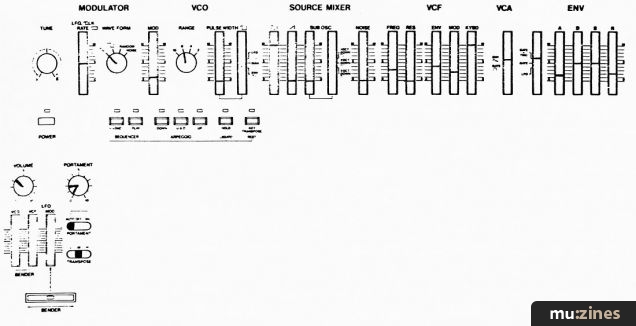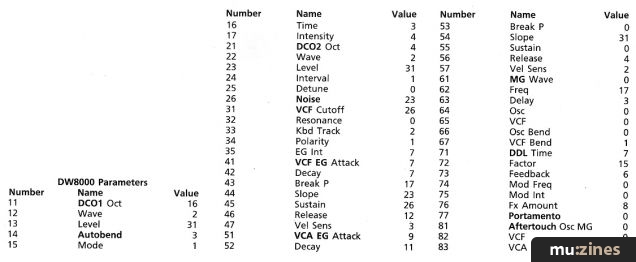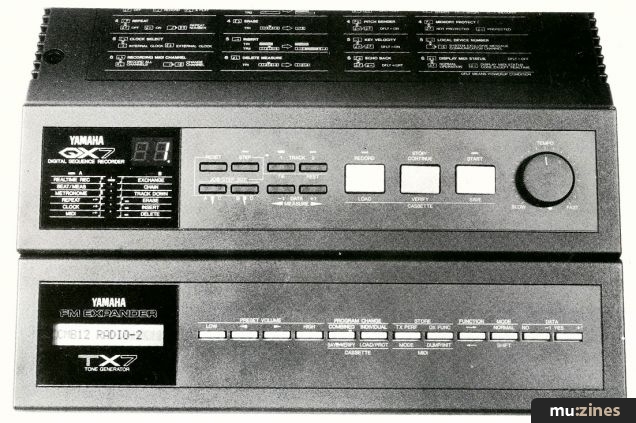Magazine Archive
Home -> Magazines -> Issues -> Articles in this issue -> View
Steve Gray on the DX7 | |
Article from Electronics & Music Maker, December 1983 | |
Sky's keyboardist was one of the first musicians to take the Yamaha DX7 on the road for the band's last tour, here he explains how it stood up to the rigours of the road.
The SKY keyboardist reports on how this revolutionary instrument performs on the road.

Basically, for live work I have a three-keyboard set-up. On the left is a harpsichord, which has a hard-wired interface to the Oberheim OBXa. That's more or less a permanent fixture that I think would be very difficult to change if ever I wanted to. In the centre, facing the front of the stage, I have a piano hard-wired to the Jupiter 8 through a bar which is fitted to the piano. In fact the bar can be removed and fitted to any other piano I want. The system was developed by our engineer, Andrew Jones, and I believe Ultravox now use a similar system on stage.
To the right is what I call the variable section, which changes according to the material we're doing at the time. Last time we contacted Yamaha and asked if it would be possible for us to borrow a GS1. It's a truly incredible machine and we wrote a lot of material on it, but inevitably the manufacturers wanted to have it back after a while. I considered that a big problem at first but in retrospect I didn't like the non-programmable aspect of it.
It was about this time that I first heard about the DX7, and when I first played it while we were out in Japan it seemed like an excellent compromise. The only problem was that at the time they were a bit like gold-dust and it was only about a week before the start of the tour that we actually managed to get our hands on one.
Basically, the DX7 is fantastic, so anything I say has to be taken in that context. In a way I think it's the biggest advance since the polysynth. With a week to go before the tour, the first thing I had to learn was how to program the thing. I'm not a snob about using pre-programmed things - the guys who put them in there are obviously very talented programmers and they have rather more experience of the DX7 than me. So I used the factory programs, though not exclusively because when it comes down to it, the DX7 is very easy to program although it can be a little bit slow. The fact that there are six envelope generators with eight steps each makes the possible combinations that much more complex. On the other hand, having six envelopes is great because being able to use the generators properly is half of getting a good sound on an instrument like this. Once you've mastered that, the actual development of sounds becomes quite easy.
Working with the DX7, I found I didn't like the strings all that much, and that's not just a personal thing because I've spoken to other DX7 owners and they're pretty much agreed that the string sounds aren't really up to it. Then again, I don't use strings very much with the band anyway, so it's not as important a flaw as it might sound. Most of the rest of the sounds on the DX7 are very good. Almost all the basic tones that come out of it are usable, and it's possible to emulate a lot of the GS1 sounds with it - obviously an advantage for me having gone from one instrument to the other. Finding covers for the GS1 sounds was quite easy, even though we only had a week and I'm not the fastest programmer in the world. It was all just about ready in time for the tour.

Turning to the machine on the road, the first thing to say is that there were no problems whatsoever with reliability or tuning. I never really got the hang of the block-diagram, because the first instrument I saw in Japan didn't have it, so I suppose it must have been something they added when they went into full production. On the other hand that isn't really a thing you would use much on the road, whether you understood it or not.
Getting the hang of the machine sufficiently for it to take the place of the GS1, and for me not to make too many gross errors on stage, was aided a lot by the owners' manual Yamaha supplied, which is very good indeed. It takes you through the instrument logically so that you can actually see what is happening at each stage. Manuals can be a problem because each manufacturer tends to use his own (non-standard) terms, and they make it difficult to learn your way round an instrument quickly.
"Basically, the DX7 is fantastic, so anything I say has to be taken in that context."
The DX7 manual was a pleasant change from all that and, using it in conjunction with the review in E&MM, I was able to pick up on the workings of the instrument without long hours of study.
Then I got to the actual programming stage. I asked myself whether the sound I wanted was complex or simple. In the case of the simpler sounds I used carriers rather than modulation because it's so much easier to work that way. If, say, I was in the middle of a session and someone asked for a sound to be made a little brighter, I'd rather just step up the algorithms than go searching in the machine for the sound I want... it makes the whole process that much faster.
On stage, the DX7 sounds as good as when you programmed it, I've played quite a few synths where the programmed sound have been great but the stage sound from the same programs really hasn't been very good at all. The DX7 holds the sounds and gives them back just as I put them in.
The keyboard is good as well. It actually caught me out a few times because it led me into thinking it was better than it really was, and I began playing it the way I would a piano. This leads me on to the question of variable keyboard pressure, because I really think instruments like this really ought to have that facility. When you think about it, everybody has their own 'feel' on a keyboard. Then again, there are quite a number of little additions I would like to see, like an individual aftertouch facility on separate notes rather than on the whole keyboard.
The program selection on the DX7 is fairly good, but there will always come a time when you hit two of the controls at once, because they're touch-sensitive. Every time you hit two instead of one, you get this great sonic explosion from inside the synth, which has a certain novelty at first but gets tiring very quickly. Mistakes like that are bound to happen, and I think the multifunction buttons on the DX7 are a drawback live, especially if you have a multi-keyboard set-up. Some of the functions are just unusable live, like the Functions mode and the Edit mode, though I suppose if you've done your homework beforehand you shouldn't really need to use them.
The main problem is one of time. At the end of a song I might have to, say, unlock the interface with the harpsichord, unlock the piano, change the settings on the JP-8, all in a matter of a few seconds. Which brings me on to the fact that it's hard to see which program the DX7 is using at any one time. It may be something Yamaha just haven't thought about because I seem to remember the GS1 was just the same.
"The keyboard is good... it caught me out a few times because it led me into thinking it was better than it really was, and I began playing it like a piano."

At the end of a song the lights fade to black and there's a nice little light to tell you which program you're on, and none to tell you where the others are! It would be lovely if you could reverse it so that the program that's in use is the only LED not lit; that way you could get a quick visual grasp of what is set, and you could accomplish a very fast change, even in the dark.
With the DX7 you've got two rows of 16 blocks, with green lights and white lettering, and you don't get to see very much of that when the lights are down. By the time we got to the middle of the tour things had improved a little because I could feel my way around almost by instinct - I could get reasonably close to each program just by knowing its basic location.
Being in Normal mode all the time is a problem because the performance controls aren't programmable, so much of the expressive aspect of the instrument is lost. I can't use the Aftertouch because I play like a pianist anyway.
I have the pitch-bend set to a tone, because that's all I use normally, and also I have the mod wheel with an innocuous amount of vibrato on it. As far as the breath controller goes, I prefer the CS-01 anyway... I think it's a great little machine even though it's only monophonic. So I think another possible improvement for the DX7 would be to have the performance controls fully programmable.
The hardest aspect of my working on stage is the logistics of making sure I'm at the right keyboard at the right time. For the first week of a tour I can't concentrate on the music that much, because I'm spending all my time getting all the switching right. There's one particular piece where the DX7 has to change programs in almost no time at all; the end of one bar is one program and the downbeat of the next is another. The changing on the DX7 is not quite as positive as it is on the GS1, so I have to come off a beat early to get enough time to change programs. That was how I discovered the musical explosion - when I hit the controls badly there was this enormous crash!
Finally, setting up on stage is very easy indeed. Straight out of the flightcase and away. I use the volume pedal, which I like very much, and the sustain pedal because it helps me get as close to the original GS1 sounds as possible. I also use the portamento pedal occasionally though I don't think I used it much on the last tour.
What really amazes me is the difference in price between the DX7 and the DX1. I would have thought there'd be a market for something like a DX5, which would be a sort of midpoint between the two, with Aftertouch on individual notes and that complete programmable stage function.
Also featuring gear in this article
BeeBMIDI (Part 3)
(EMM Aug 84)
BeeBMIDI (Part 7)
(EMM Mar 85)
Hands On: Yamaha DX7
(SOS Dec 92)
Load Baring
(12T May 85)
Load Baring
(12T Aug 85)
One For The 7 - DX7 Patch
(ES May 85)
One Off - DX7 Patch
(ES Apr 85)
Sight Reading - Yamaha DX7 Digital Synthesizer
(EMM Apr 85)
The Right Connections
(ES Oct 84)
The Synths Of The Year Show - Synthcheck
(IM Dec 85)
Understanding the DX7 (Part 1)
(EMM Apr 84)
Understanding the DX7 (Part 2)
(EMM May 84)
Understanding the DX7 (Part 3)
(EMM Jun 84)
Understanding the DX7 (Part 4)
(EMM Jul 84)
Understanding the DX7 (Part 7)
(EMM Oct 84)
Yamaha DX-7 Synthesiser
(MU Aug 83)
Patchwork
(EMM Feb 84)
Patchwork
(EMM Mar 84)
Patchwork
(EMM Apr 84)
Patchwork
(EMM May 84)
Patchwork
(EMM Jul 84)
Patchwork
(EMM Aug 84)
Patchwork
(EMM Jan 85)
Patchwork
(EMM Feb 85)
Patchwork
(EMM Apr 85)
Patchwork
(EMM Jun 85)
Patchwork
(EMM Jul 85)
Patchwork
(EMM Feb 86)
Patchwork
(EMM Mar 86)
Patchwork
(EMM May 86)
Patchwork
(EMM Jun 86)
Patchwork
(EMM Aug 86)
Patchwork
(EMM Sep 86)
Patchwork
(MT Nov 86)
Patchwork
(MT Dec 86)
Patchwork
(MT Jan 87)
...and 19 more Patchwork articles... (Show these)
Browse category: Synthesizer > Yamaha
Featuring related gear
A Sound Design - Design Studio Programs
(ES Jan 85)
Delirious Xcitement - Yamaha DX7S
(SOS Mar 88)
Double Take - Yamaha DX5
(ES Apr 85)
Expand your DX
(SOS Jan 87)
Hi-Tech Xpansion
(EMM Apr 85)

Pandora's Box
(MIC Oct 89)
Russ DX7 AI Editor
(SOS Apr 88)
Temperament
(MM Apr 87)
The Fifth Dimension - Yamaha DX5
(EMM Oct 85)
The Legend Lives On - Yamaha DX7IID
(SOS Mar 87)
Tips To Tame the DX7II
(SOS Mar 88)
TX7 - To The Limit
(SOS Jun 86)
Yamaha DX5 - Synthcheck
(IM May 85)
Yamaha DX7-IID Synth
(MM Mar 87)
Patchwork
(MT Feb 88)
...and 2 more Patchwork articles... (Show these)
Browse category: Software: Editor/Librarian > Sound Design Studio
Browse category: Synthesizer > Yamaha
Browse category: Expansion Board > Grey Matter Response
Browse category: Synthesizer Module > Yamaha
Browse category: Software: Editor/Librarian > Joreth Music
Browse category: Software: Editor/Librarian > Pandora
Browse category: Software: Editor/Librarian > - (No Manufacturer)
Browse category: Software: Editor/Librarian > Steinberg
Publisher: Electronics & Music Maker - Music Maker Publications (UK), Future Publishing.
The current copyright owner/s of this content may differ from the originally published copyright notice.
More details on copyright ownership...
Feature by Steve Gray
Help Support The Things You Love
mu:zines is the result of thousands of hours of effort, and will require many thousands more going forward to reach our goals of getting all this content online.
If you value this resource, you can support this project - it really helps!
Donations for April 2024
Issues donated this month: 0
New issues that have been donated or scanned for us this month.
Funds donated this month: £7.00
All donations and support are gratefully appreciated - thank you.
Magazines Needed - Can You Help?
Do you have any of these magazine issues?
If so, and you can donate, lend or scan them to help complete our archive, please get in touch via the Contribute page - thanks!









